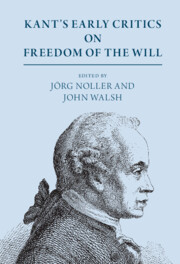Book contents
- Kant’s Early Critics on Freedom of the Will
- Kant’s Early Critics on Freedom of the Will
- Copyright page
- Contents
- Acknowledgements
- Note on the Edition and Translation
- Chronology of the Translated Texts and Kant’s Major Works
- Abbreviations
- Historical and Systematic Introduction
- I Freedom and Determinism
- II Freedom and Imputability
- III Freedom and Consciousness
- IV Freedom and Skepticism
- V Freedom and Choice
- Immanuel Kant, Preliminary Notes and Reflections to the Introduction to the Metaphysics of Morals, Before 1797
- Immanuel Kant, Introduction to the Metaphysics of Morals, 1797
- Karl Leonhard Reinhold, “Some Remarks on the Concept of the Freedom of the Will, Posed by I. Kant in the Introduction to the Metaphysical Foundations of the Doctrine of Right,” in Auswahl vermischter Schriften, Volume ii, Jena, 1797, 364–400
- Friedrich Wilhelm Joseph Schelling, “General Overview of the Most Recent Philosophical Literature,” Philosophisches Journal 7(2) (Jena and Leipzig, 1797), 105–186
- Appendix: Biographical Sketches
- Glossary
- Notes
- Bibliography
- Index of Persons
- Index of Subjects
Immanuel Kant, Introduction to the Metaphysics of Morals, 1797
from V - Freedom and Choice
Published online by Cambridge University Press: 24 March 2022
- Kant’s Early Critics on Freedom of the Will
- Kant’s Early Critics on Freedom of the Will
- Copyright page
- Contents
- Acknowledgements
- Note on the Edition and Translation
- Chronology of the Translated Texts and Kant’s Major Works
- Abbreviations
- Historical and Systematic Introduction
- I Freedom and Determinism
- II Freedom and Imputability
- III Freedom and Consciousness
- IV Freedom and Skepticism
- V Freedom and Choice
- Immanuel Kant, Preliminary Notes and Reflections to the Introduction to the Metaphysics of Morals, Before 1797
- Immanuel Kant, Introduction to the Metaphysics of Morals, 1797
- Karl Leonhard Reinhold, “Some Remarks on the Concept of the Freedom of the Will, Posed by I. Kant in the Introduction to the Metaphysical Foundations of the Doctrine of Right,” in Auswahl vermischter Schriften, Volume ii, Jena, 1797, 364–400
- Friedrich Wilhelm Joseph Schelling, “General Overview of the Most Recent Philosophical Literature,” Philosophisches Journal 7(2) (Jena and Leipzig, 1797), 105–186
- Appendix: Biographical Sketches
- Glossary
- Notes
- Bibliography
- Index of Persons
- Index of Subjects
Summary
In the Introduction to the Metaphysical Foundations of the Doctrine of Right, Kant assigns the will the function of giving laws and identifies it with practical reason. As merely lawgiving, Kant maintains, the will is neither free nor unfree: only the power of choice can be called free by virtue of its relation to action through maxims. Kant argues that this freedom cannot be defined as the capacity to choose for or against the moral law because this phenomenon of choice pertains to the human being qua appearance and therefore cannot define freedom, which is necessarily intelligible. For Kant, the negative concept of freedom of the power of choice consists in independence from determination by sensible impulses and the positive concept consists in the ability of pure reason to be practical. Furthermore, he claims that the possibility of deviating from the moral law is an incapacity (Unvermögen). Thus, Kant seems to hold that freedom is restricted to moral action. Nevertheless, there is room for interpretation: Kant’s remark might not be a blanket statement about free will per se but a specific claim about its definition. The matter is still contested in the secondary literature.
Keywords
- Type
- Chapter
- Information
- Kant's Early Critics on Freedom of the Will , pp. 232 - 237Publisher: Cambridge University PressPrint publication year: 2022



